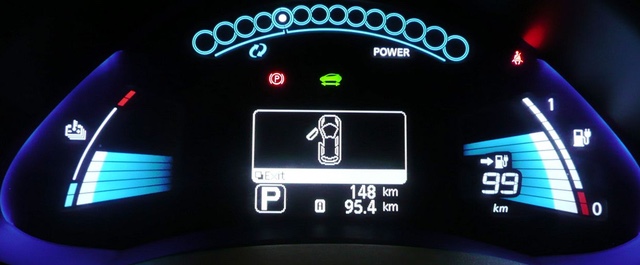Tricks to Maximizing Electric Car Mileage
Driving the Nissan Leaf car is unlike any vehicle I’ve ever driven. There’s a clear and direct effect on mileage based on driving habits. And, thanks to an almost constant stream of information, I’m also able to understand how the battery’s usefulness translates to battery usage. Some of this feeling was similar to the previous hybrid I drove, but not like this. Over time I’ve driven electric, I’ve learned a few tricks on how to maximize this mileage.
First, it’s important to know what’s unique about a Nissan Leaf. The KM gauge (sometimes called the “Guess o’ Meter” or GOM) is not terribly useful for determining how much battery you have left. Rather, it can be useful for understanding the impact of your driving. Regularly, you can watch it increase or decrease based on using faster roads and turning on the climate control. It’s kind of a rolling warning system.
The single worst way to drive this car (for range) is to use it at higher speeds (such as the highway). This would seem counter to the way gas cars work. The battery use for me is much more pronounced in a longer highway run, but I can limit this by driving slower and behind trucks. The wind drag on this car can directly change the mileage, but it’s not clear if behind (or beside) a truck is the best way to minimize wind drag. Also, my Leaf appears to be very weight sensitive. Having another passenger in the car consumed a noticeable amount of energy over myself alone.
There is hope, however. On a mammoth 230 kilometre day of driving, I needed to drive on the highway for more than 100 kilometres in one run. Even more challenging, the battery was not fully charged. I needed to get that distance from what I had. With some basic tactics like driving behind large vehicles, keeping the speed lower and attempting to regenerate brakes when driving downhill, I was able to make the full with some battery to spare. I also stayed close to areas with known EV chargers just in case.

Weight is another consideration. It’s become clearer why this car doesn’t have a spare tire. Since the range is limited, you’ll probably not be able to drive this to the very remote areas (yet), so you’ll probably always need to be in a reasonable range of roadside assistance. Since I recently picked up snow tires, I expect there may be cases where I’ll take an extra tire, jack and wrench for a longer trip. It seems like a reasonable thing to do in some scenarios, though I have yet to do it.
After using snow tires for a week, I also realized that they were reducing my mileage 10% to 20% (roughly). Given the fact that cold weather driving already reduces the battery’s range, snow tires seemed to exacerbate that challenge. I realized they weren’t as useful as I’d like (and probably not as important as I thought), so I stopped using snow tires. That was an expensive lesson to learn.
One scenario had me worried (and subsequently using a borrowed gas car). I had finished with a client in Toronto and had perhaps 50% charge. There was enough to get back home (50km away), so I just started heading back. About 80% into my return trip (with about 45km left on the GOM), I realized I had left my wallet in Toronto. I called ahead and they were holding on to it, but I needed to get back right away to pick it up – and had no time to charge. In this case, a gas car was the only way I could get back in a reasonable timeframe.
Some of my experience driving so far from a 100% charge (with charge bars left on arrival):
1. All side roads, no highway (no public charging), 25.2km – 10 bars left
2. Mostly slow, some highway (no charging), 136km – 3 bars left
3. Mostly a toll highway (charged three times), 230km – 2 bars left (low battery warning)
4. Worksite (charged on-site 120 volt), 185km – 3 bars left
Over time I’m learning to better understand what’s possible with this car. This has lessened my worries about any sort of sudden power loss while helping me to plan a little better. Unplanned situations usually force me to borrow a gas car until I can better trust the current charging infrastructure. And I’d say it’s poor, at best. Often people ask me “Aren’t you afraid of being stuck somewhere?“. I tend to reframe the idea as “I’m afraid that wherever I am if I need a charge, there is no charging station“. This happens far more often than I’d expected.
Access to charging stations and locations is an ongoing problem. What information that exists is improving, but limited. Costs for parking or access, coupled with dealerships that aren’t clear about whether chargers are publicly available, make the environment for an EV driver much more hostile than it should be. In many installations, the electric car parking is located in a place that leads to regular abuse (ICE’d), or parking rules are not enforced. I’ve also come across broken chargers that are simply not fixed because it may be such a low priority.

